Adapting to changes in the Indian telecom market for a comeback

Vodafone Idea : Imagine the busy streets of Chennai, Delhi, and Mumbai. The symphony of car horns and conversations is harmonizing with the beeping sounds of smartphones everywhere. This is a testament to India’s burgeoning mobile revolution. In this environment, Vodafone Idea (Vi) once reigned as a towering telecom giant boasting millions of subscribers.
However, the past few years have been a roller coaster ride for the company. A story of dominance, then decline, and now an unexpected glimmer of hope. Recently, on New Year’s Day, Vodafone Idea Ltd experienced a notable peak in speculation that the government might consider selling its 33% stake in Vodafone Idea to Elon Musk’s satellite internet venture Starlink in partnership with the telco. However, the agency immediately issued a statement dismissing these claims as false.


Vodafone Idea Limited (formerly Idea Cellular Limited) is currently the third largest telecom operator. According to the Telecom Regulatory Authority of India, Vodafone had a market share of around 19.62% on subscription basis with a subscriber base of INR 23.03 billion in the first quarter of fiscal 2024.
This article takes a closer look at Vi’s tumultuous journey, examining the complexities of Vi’s financial difficulties, significant government intervention, and the recent surge in its stock price that has energized investors.
Vodafone Idea
business overview
Vodafone Idea (Vi) boasts a history as rich and dynamic as the country itself. Its roots go back to two separate journeys: Vodafone India, a global telecom giant that entered the Indian market in 2003, and Idea Cellular, a homegrown powerhouse founded in 1995. Let us understand their journey of coming together as one company.
Vodafone Group Plc, a British multinational telecommunications company, has long played a prominent role in the global telecommunications landscape. Founded in 1991, Vodafone quickly expanded to become one of the world’s largest mobile network operators. However, its subscriber base was still small compared to the vast sea of Indian consumers.
On the other hand, Idea Cellular, an Indian mobile carrier, has established itself as a significant force in the Indian telecommunications market. Founded in 1995, Idea has played a pivotal role in providing affordable and accessible mobile services to the masses. Idea, one of India’s leading telecom operators, has focused on expanding its network coverage and enhancing services to meet the changing needs of its diverse customer base. This mass-market focus broadened its subscriber base, but its average revenue per user (ARPU) was still lower than Vodafone’s. The reason the two companies came together was Reliance Jio’s entry into the Indian market in 2016.
Reliance Jio enters the market – turbulence in the telecom industry
The merger of Vodafone and Idea was largely influenced by Reliance Jio’s entry into the Indian telecom market. Launched in 2016, Reliance Jio revolutionized the industry by offering affordable data plans and free voice calls, leading to a sea change in consumer preferences.
Reliance Jio’s competitive pricing strategy has undermined the fierce price wars and profit margins of incumbent telcos, including Vodafone and Idea. The relentless expansion of Jio’s user base has put pressure on existing players, leading to a significant decline in their market share and financial performance.
To counter the challenges posed by Reliance Jio’s disruptive tactics, Vodafone and Idea have discovered strategic advantages in collaborating. The merger allowed the two companies to pool resources, share infrastructure, and strengthen their market positions. Vodafone Idea Limited aimed to create a bigger and stronger company to strengthen its competitiveness, navigate the aggressive pricing environment and collectively face the enormous challenges presented by Reliance Jio.
Vi initially promised a subscriber base totaling more than $40 million. However, stiff competition from Reliance Jio and Airtel and high spectrum acquisition costs have plunged the company into a debt spiral.
It didn’t end here. As companies struggle to adapt to mergers and survive in the fierce competition, the Supreme Court’s 2019 ruling on adjusted gross revenue (AGR) dues has imposed significant financial obligations on telcos.
How did AGR get Vodafone into trouble?
The telecom sector in India is required to pay annual dues to the Department of Telecommunications (DoT) calculated as a percentage of Adjusted Gross Revenue (AGR).
The AGR case arose from a dispute between telcos and DoT over the definition of AGR, which determines range usage and allowable fees that telecom providers have to pay to the government.
The ongoing disagreement centers around the definition of AGR, a key element of the dues calculation. At the time, telecom providers paid 3-5% of the AGR as spectrum usage fees and 7-8% as license fees. DoT asserts that AGR should include interest income, dividends, gains on sale of assets, insurance claims and foreign exchange gains.
Telecom companies argued against including non-telecom revenue sources such as other income in the calculation of AGR. However, the Supreme Court disagreed and asked major telecom companies such as Vodafone Idea, Reliance Jio, Bharti Airtel and others to pay dues of around Rs 1.19 lakh crore.
Government Intervention: A Lifeline Thrown Out
With the company mired in exorbitant costs, the Indian government announced a package of reforms. With this, Vodafone has decided to defer Spectrum and AGR payments for FY22 and convert the interest accruing on these deferrals into equity.
On February 3, 2023, the Ministry of Telecommunications, Government of India passed an order to defer spectrum auction installments and convert the loan amount representing net present value of interest related to AGR dues into equity shares to be issued to GoI. The company issued 16.13 billion equity shares at an issue price of Rs 10/-.
Promoter stake in the company decreased from 74.99% in FY2022 to 50.4% in FY2023. Currently, the Indian government holds a 33.1% stake in the company. Vodafone is trying to climb the ladder again with support from the Indian government.
Vodafone Idea’s rebound: A step towards a potential comeback?
Vodafone Idea (Vi) is recovering from the crisis. After a steep decline in subscribers, Vi is taking several steps to regain its footing. They are reducing costs through network sharing and strategic staffing, while attracting customers with competitive data plans and improved services.
The government’s financial lifeline is helping ease the pressure, while Vi is looking to sell non-core assets and tap high-yielding markets such as corporate and rural services.
They are also stepping up their technology game, accelerating the rollout of 4G and preparing for 5G. Above all, Vi is committed to transparency and innovation to restore trust and carve a unique niche in the competitive environment. Whether reclaiming the throne or blazing a new path, Vi’s comeback attempt is a story of resilience in the dynamic world of Indian telecoms.
Now let’s take a look at the company’s current financial position.
Vodafone Idea – Finance
Let us take a look at Vodafone Idea’s financial health to understand its future dynamics.
Vodafone Idea (Vi), once a giant in India’s telecom sector, has seen its subscriber base decline sharply in recent years. This escape, marked by empty phone booths and quieter call centers, depicts Vi’s struggle for survival in a fiercely competitive market.
Let’s look at the 4-year subscription rate.
| 2022 | 2021 | 2020 | 2019 | |
| Subscription fee (unit: crore) | 24.20 | 26.61 | 28.48 | 33.30 |
| subscription rate | 20.68% | 22.58% | 24.26% | 28.40% |
According to the company’s annual report, Vodafone Idea’s FY23 subscription rate is 20.7%. The company continues to see declining subscription rates. However, over the past few years the rate of decline has been slightly smaller.
The company reported net revenue of Rs 42,177 crore, up 9.5% year-on-year, and posted a net loss after tax of Rs 29,301.1 billion in fiscal 2022-23, compared to Rs 28,245.4 billion in the previous year.
The company had a negative ROCE of 5% in FY2023 compared to 6% in FY2022. As of March 31, 2023, the company’s net debt increased by Rs 11,892.5 from Rs 1,89,458.8 in FY22 to Rs 2,01,351.3 Crore in FY23.
conclusion
The Vodafone Idea series is a compelling story of resilience in the face of adversity. The company’s struggle for survival, fueled by government intervention and internal improvement efforts, provides a valuable case study for corporate turnaround strategies. Although challenges remain, Vi’s recent stock surge and focus on strategic improvement offer glimmers of hope for a brighter future.
The telecommunications giant’s continued success depends on its ability to leverage new technologies, optimize costs and deliver superior customer experiences. Only time will tell whether Vi can truly rise from the ashes and regain its position as a leader in the Indian telecom industry.
What do you think about this? Do you think Vodafone can make a comeback? Let us know what you think about this in the comments section below!
Written by Akshita Malu
By leveraging the Stock Screener, Stock Heatmap, Portfolio Backtesting and Stock Comparison tools on the Trade Brains portal, investors have access to comprehensive tools to identify the best stocks, stay updated and informed with stock market news. invest.


Start your stock market journey now!
Want to learn stock market trading and investing? Check out exclusive stock market courses from FinGrad, a learning initiative from Trade Brains. You can sign up for free courses and webinars from FinGrad and start your trading career today. Sign up now!!



